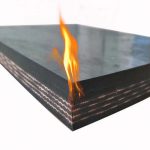Development trend of rubber flame resistant conveyor belt
With the development of the coal industry, a large number of large mines of 5 million tons or even more than 10 million tons have been built in succession, and the demand for large, high-strength, flame-resistant conveyor belts has been increasing. Very large mines require flame resistant belts greater than 1600 mm or greater than 3000 mm wide and greater than 2500 N/mm or even 4000 N/mm in strength, which require high strength and long service life due to their large load capacity and long belt distances. At the same time, the need for thin belts, low weight, investment savings and energy consumption requires new carcass materials to meet the requirements.
New materials and continuous production. The strength of the flame resistant belt depends primarily on the material of the entire carcass. At present, the entire length of the weft and weal belt carcass in China is based on the cotton yarn or the polyamide/cotton yarn, with the belt thickness, weight, and strength low. In foreign countries, polyester or aramid fibers are usually used as a longitudinal thread, while polyamide and cotton yarns are used in the latitudinal thread, thus they are characterized by thin, light weight and high strength. With the trend of high performance, thin lamination and lightweight, aramid fibers should be preferred as the lead for the entire carcass with strength above 3000 N/mm, making the belt light and thin, making it easy to dip and plasticize, greatly increasing the strength of the belt and extending its service life.
Wide variety and application. At present, PVC and PVG flame resistant conveyor belts in China are mainly used in coal mines. In fact, it can be used for material transport anywhere except for high temperature materials. In foreign countries, there are not only flame resistant belts for coal mines but also general purpose flame resistant belts for coal and non-coal mining industries. However, flame resistant belts for coal mines have stricter requirements for flame retardancy.
Energy efficient, safe, environmentally friendly. Energy efficiency, safety and environmental protection are the trend in the belt industry. PVC and PVG flame resistant belts are energy efficient, safe and environmentally friendly. High-strength, flame resistant belts have long service life and are able to take full advantage of resource efficiency. The thermoplastic elastic surface flame resistant belt is simple, low energy consumption, high productivity, and the glue can be reused. It is a product that is economical to recycle, energy efficient, safe, and environmentally friendly. Low-toxicity, low-smoke, flame resistant belts are a safer and more environmentally friendly product.
Talent, technology, markets and benefits are concentrated in a few enterprises. At present, there are more than 80 enterprises in China producing PVC and PVG flame resistant conveyor belts, most of them small enterprises and more than 10 medium and large conveyor belt enterprises. There are only 10 enterprises in foreign countries producing similar products, most of them large enterprises and world-renowned brands. In recent years, the domestic market and benefits of flame resistant belts have gradually been concentrated in foreign-funded enterprises and medium- and large-scale enterprises. With the entry of foreign-invested enterprises and the launching of quality credit activities and the implementation of brand name strategies in the domestic conveyor belt industry, the market and benefits are increasingly concentrated in a few powerful enterprises, while the manpower, capital and technology are gradually being transferred to a few powerful enterprises.

Tags: Flame resistant conveyor belt






